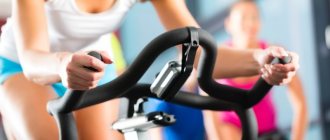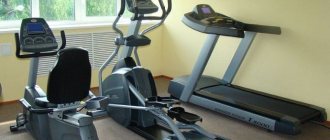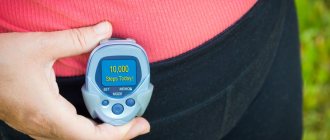Features of training on a treadmill
- One of the advantages of working out on a treadmill is the shock absorption system , which softens impacts that negatively affect the joints and spine. Accordingly, running on a track is much more comfortable and safer than running on asphalt.
- The treadmill is fully adapted for a comfortable workout for the user , including location (conditions), the presence of heart rate monitors for constant heart rate monitoring, special weight loss programs that take into account the user’s personal parameters, such as gender, weight, age, to determine the individual appropriate load.
Read more about how to choose the right treadmill →
Who is the exercise recommended for?
Walking briskly on a treadmill is ideal for losing weight. Among athletes, such training is called “drying” the body. It is also an effective cardio training for developing endurance. Its beneficial effect for the body as a whole is expressed in improved blood circulation without unwanted stress on the knee joints.
Race walking is suitable for the following categories of athletes and people leading a healthy lifestyle:
- Anyone who has knee problems. These are injuries and chronic diseases. Walking on a treadmill will help you maintain stable physical shape without aggravating your knees.
- For everyone who is just starting to master training in the gym and is choosing a personal set of exercises. Walking is an excellent cardio exercise for developing endurance.
- To all athletes who suffer from hypertension. Interval walking allows you to keep your heart rate while walking on a treadmill within 115-130 beats per minute.
- For everyone who has only recently gotten rid of the bad habit of smoking, and whose respiratory system is not able to withstand intense stress. Regular walking for a month will help you forget about shortness of breath. It will ensure the normalization of the heart and blood vessels and the necessary oxygen supply to muscle cells. This will allow you to move on to full-fledged training in the gym in the future.
How to properly run on a treadmill
First of all, it is necessary to follow safety requirements; this will not only prevent injuries, but will also extend the life of the simulator itself.
- Before turning on the track, you need to place your feet on the sides on special sides, and then start the belt using the “start” button. When the belt begins to move, without increasing speed, place your feet on the track one at a time, only then slowly increase your walking speed.
- Start your workout with brisk walking , this is necessary to warm up the muscles and ligaments, as well as to gradually increase your heart rate and, accordingly, safe and proper heart function.
- Do not exceed the speed limit if you are at the maximum permissible heart rate limit. If, having previously set a fat burning program, or simply monitoring your own heart rate zones using cardio sensors, your heart rate is too high, do not reduce the speed sharply. Reduce your speed by 2-3 km/h and level out your heart rate, reaching the desired weight loss zone.
- Never stop abruptly. To complete the run, gradually reduce your speed to a walk over 2-3 minutes. After the heart rate has decreased and the step has become slow (at minimum speed), press the “Stop” button, only after the belt has completely stopped, leave the path.
How to lose weight by walking?
The process of breaking down fat and losing weight while walking fast on a treadmill is by no means a myth. Knowledge of physiology and technical aspects allows you to make training as effective as possible. Let's take a closer look at them.
- Firstly, the effectiveness and efficiency of a treadmill walking program for weight loss depends on the time of day you choose to exercise. The ideal option for enhancing fat burning is the morning before meals. Why is this so? In the morning, catabolic processes dominate in the body. The level of glycogen in the liver and muscles is minimal. Therefore, the main source of energy is subcutaneous (visceral) fat. It is actively consumed by the body during morning training on an empty stomach.
- Secondly, it is recommended to include walking in the training program after strength (functional) training. Moderate-intensity cardio increases calorie expenditure, which provides an increased fat-burning effect.
- Thirdly, the effectiveness of classes depends on their regularity. The optimal number of workouts per week, if no other loads are provided, is 4-5 sessions. If you are a fan of strength training and weight training, include walking on the treadmill less often (2-3 times a week).
Another secret to an effective treadmill workout is variety. An increase in endurance and the formation of reserves of the respiratory system is facilitated by alternating walking at a fast pace with running. An excellent training option is interval walking (alternately at a fast pace, at a walking pace). You can increase the load by choosing to walk with an incline on a treadmill. Choose from the options listed the one that suits you. Regular exercise in race walking allows you to lose excess weight and also avoid gaining it in the future. By adjusting two parameters: the angle of inclination of the track, the speed of movement, you can adapt the training to suit you.
To achieve ideal physical shape, walking on a treadmill is combined with proper nutrition. Gradual weight loss with this approach will give the desired and, most importantly, stable results.
The benefits of running on a treadmill
- Strengthens the cardiovascular system, improves blood circulation, normalizes blood pressure.
- Prevents the development of muscle atony, strengthens the muscles of the whole body.
- Improves respiratory function.
- Promotes safe weight loss due to the high energy costs of running.
- The shock absorption system makes training safe, maintaining joint mobility and spinal health.
- The ability to track your heart rate using cardiac sensors makes training safe, preventing you from overloading your heart muscle or increasing your blood pressure.
You may feel dizzy
Many people don't like to run on treadmills because they feel dizzy after exercising. “If you use your hands on the machine to maintain balance, your internal balance system is not working,” says Changha Hwang, a physical therapist. “When you step off the canvas, the balance system will suddenly turn on again, and you will feel dizzy or floating in space.” To reduce discomfort, walk more slowly on the treadmill and, again, avoid holding the handrails with your hands.
How to run on a treadmill for weight loss
The treadmill can make your workout easier by automatically detecting the exerciser's heart rate zone. When setting personal parameters, the program calculates 60-70% of the maximum heart rate. If the track functions do not provide this, calculate the heart rate zone yourself:
- (220 – age) * 0.6
- (220 – age) * 0.7
Once you have two values, train without going beyond your individual zone. Plus, this will be the best heart rate for burning fat on the treadmill without putting extra strain on your heart.
Depending on your age, weight, and fitness level, even walking on a treadmill may help you lose weight if your heart rate is in the right range.
Interval training on a treadmill is also suitable for fat burning - alternating equal intervals of running and walking. Controlling your heart rate for fat burning will also remain an important condition Even if the entire workout will take place uphill (at an incline), here too it is important to ensure that the heart rate does not fall below the minimum value or exceed the maximum. And another article has a lot of interesting information about walking uphill on a treadmill.
Do workouts every other day , do not exceed four sessions per week. The duration of the training depends on the chosen program.
- If you plan to do interval training or running at one speed, 30-40 minutes is enough, after which you need to calm your heart rate while walking and stretch.
- And if you want to walk uphill, taking into account your individual heart rate zone, the workout can last 50-60 minutes.
What muscles work?
Walking on a treadmill promotes the harmonious and versatile development of the body. Like running, walking affects all skeletal muscle groups:
- Muscles of the legs. The gluteal, calf and thigh muscles receive the load.
- Muscles of the shoulder girdle. Brisk walking engages the shoulder girdle through rhythmic arm movements.
- The cardiovascular system. Aerobic exercise maintains the tone of the heart and blood vessels, and trains the respiratory system. The smooth fibers of blood vessels and the heart muscle also receive stress.
- Intercostal and abdominal muscles. Their participation in walking is indirect, but they provide respiratory movements.
It is impossible to definitively answer the question of which muscles work when walking on a treadmill. Of course, you shouldn’t expect to develop biceps from walking. However, regular cardio training is the key to a toned figure and elastic muscles. Walking at a sporting pace is irreplaceable if the goal of training is to “dry” the body. This type of load ensures more efficient functioning of the body, rather than its individual parts. Other exercise equipment is designed to create an athletic profile and develop muscles, for example, complexes with weights and free weights.
Treadmill training program
Option #1
Warm-up: walk for 5 minutes at a speed of 5 km/h.
- running at a speed of 10 km/h for 3 minutes;
- walking 5 km/h 2 minutes.
Perform a set of 6 approaches (30 minutes), alternating running and walking. At the end of the complex, slow down and walk to lower your heart rate to normal. Stretch for 5 minutes.
Option No. 2
Warm up – walking for 5 minutes at 5-6 km/h.
- 3 minutes of walking at a speed of 6 km/h at an incline – an angle of 10%;
- 2 minutes of running at a speed of 10 km/h (no incline).
Repeat the complex 6 times, to cool down, walk at a speed of 5 km/h for five minutes. Finally, do some stretching.
Option No. 3 (advanced level)
Warm-up: walk for 5 minutes at a speed of 5 km/h.
- 3 minutes walk at a speed of 6-7 km/h;
- 4 minutes acceleration to 13 km/h;
- 3 minutes walk at a speed of 6-7 km/h;
- 4 minutes acceleration to 14 km/h;
- 3 minutes walk at a speed of 6-7 km/h;
- 4 minutes acceleration to 15 km/h;
- 3 minutes walk at a speed of 6-7 km/h;
- 4 minutes acceleration to 14 km/h;
- 5 minutes walk 6 km/h with a gradual decrease in speed.
Do stretches for all muscles.
Rules for effective walking
Walking fast on a treadmill will bring maximum benefits if you organize your workouts correctly and make them regular. Five rules for effective cardio are given in the table.
| No. | Rule | Description of the rule |
| 1 | Thorough warm-up | It helps to avoid injuries and muscle strains; a thorough warm-up of the knees and shin joints before starting will help increase the effectiveness of the workout. Don't forget to stretch your quadriceps and calf muscles. |
| 2 | Drinking regime | Intense sweating during fast walking on a treadmill provokes an imbalance of salt balance. You can avoid this by drinking enough water in small sips during cardio exercise. |
| 3 | Constant stride length | Steps of the same length during training are the key to a uniform pace and effective load. |
| 4 | Final cool down | It is recommended to complete the workout by walking at a walking pace (at least 10-20 minutes). This is the time of fat burning (metabolic) processes in the body, which occur due to increased heart rate. |
| 5 | Determining the optimal workout duration | From a scientific point of view, lipolytic processes at full capacity begin in the body only after 40 minutes of training. However, cadio lasting more than 80 minutes leads to processes of muscle tissue breakdown. The optimal time for walking on a treadmill for burning fat is 60 minutes. |
About the treadmill
Modern cardio equipment amazes with its variety and technology. But the basis of classes on them is always built on ordinary physics, taking into account the laws of the physiology of the body. Here we always deal with concepts such as work, intensity, power, heart rate, duration, etc. That is, with specifically measurable concepts.
A treadmill in English is called a treadmill, which literally means “device for walking.” We call it a treadmill. Actually, this is a walking machine that you can run on.
The main components of the treadmill are the control panel and the running belt along which you need to walk.
Treadmill
The remote control may look very complicated, but in reality its main functions are:
- Change the driving speed using two keys (increase and decrease).
- Changing the angle of the running tape using two keys (up and down).
- Start and stop buttons.
The remote control panel may contain a lot of other buttons (fan, activation of special built-in programs, load monitor, information about the distance traveled, heart rate, inclination angle, etc.). And, frankly, no serious coach uses most of these options.
Treadmill remote control
If you work out in a gym, ask a trainer to teach you how to use the basic functions of the machine (speed, incline, on and off). If you train at home, carefully study the instructions for the simulator.
And please treat the “calorie burnt counter”, the amount of fat burned, the percentage of body fat with a certain amount of humor. This is one of the most useless functions and has almost no relation to reality.











